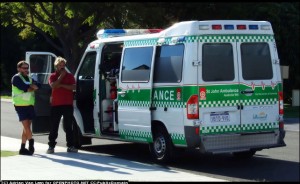Many New Jersey drivers experience confusion on how to properly act when they are on the road and encounter an emergency vehicle, whether  it is a police car, fire truck, or ambulance. Sharing the road with an emergency vehicle moving at high speeds with sirens ringing and lights flashing can create a highly anxious situation for drivers and can lead to dangerous circumstances if the driver acts incorrectly. For this reason, penalties for failing to yield to emergency vehicles can be harsh depending on the circumstances. You can receive points on your license, traffic fines by the state and by the municipality, a suspension of your license, and even imprisonment in state prison for up to 15 days. If you have encountered legal trouble arising from a failure to observe proper behavior around an emergency vehicle, please call me Corey Morano, Esq. right away at 201-598-5019 or send me an email at [email protected] and I will provide you with a free consultation.
it is a police car, fire truck, or ambulance. Sharing the road with an emergency vehicle moving at high speeds with sirens ringing and lights flashing can create a highly anxious situation for drivers and can lead to dangerous circumstances if the driver acts incorrectly. For this reason, penalties for failing to yield to emergency vehicles can be harsh depending on the circumstances. You can receive points on your license, traffic fines by the state and by the municipality, a suspension of your license, and even imprisonment in state prison for up to 15 days. If you have encountered legal trouble arising from a failure to observe proper behavior around an emergency vehicle, please call me Corey Morano, Esq. right away at 201-598-5019 or send me an email at [email protected] and I will provide you with a free consultation.
A number of different situations that constitute a violation of New Jersey traffic law can potentially arise when a driver encounters an emergency vehicle. You must give the right of way to these vehicles when they are operating on official business or in an emergency situation, usually indicated by lights and/or sirens. Unless instructed otherwise by a police officer, you must also find a safe location away from an intersection and close to the curb to pull over as quickly as they can do so provided it is in a safe manner. After the emergency vehicle has passed, you need to stay at least 300 feet behind the vehicle. Additionally, you must also stay away from a parked fire truck that is responding to a fire emergency by a distance of at least 200 feet. Even after the emergency vehicle has responded to a call, you must still maintain this separation between your vehicle and the emergency vehicle if it is flashing a red light.
Parked emergency vehicles that are displaying a flashing red or blue light need to be approached carefully. Try to switch to a lane that is not right next to the parked vehicle if traffic conditions permit. If you feel like you cannot switch lanes safely, then you should slow down your vehicle and be prepared to stop. Many drivers are also unaware that tow trucks and highway maintenance vehicles are included in this law. If you see one of them parked and displaying a flashing amber or yellow light, follow the same course of action listed above. The full statutes are listed below.
39:4-91. Right of way of emergency vehicles; liability of drivers.
a) The driver of a vehicle upon a highway shall yield the right of way to any authorized emergency vehicle when it is operated on official business, or in the exercise of the driver’s profession or calling, in response to an emergency call or in the pursuit of an actual or suspected violator of the law and when an audible signal by bell, siren, exhaust whistle or other means is sounded from the authorized emergency vehicle and when the authorized emergency vehicle, except a police vehicle, is equipped with at least one lighted lamp displaying a red light visible under normal atmospheric conditions from a distance of at least five hundred feet to the front of the vehicle.
b) This section shall not relieve the driver of any authorized emergency vehicle from the duty to drive with due regard for the safety of all persons, nor shall it protect the driver from the consequences of his reckless disregard for the safety of others. Nothing in this section shall be construed to limit any immunity or defense otherwise provided by law.
39:4-92. Authorized emergency vehicles; clearance for; following or parking near
Upon the immediate approach of an authorized emergency vehicle giving audible signal, and equipped, as required by section 39:4-91 of this Title, and unless otherwise directed by a police or traffic officer,
a) The driver of every vehicle shall immediately drive to a position as near as possible and parallel to the right-hand edge or curb of the highway, clear of an intersection of highways, and shall stop and remain in that position until the authorized emergency vehicle has passed and
b) The driver or person in control of a street car shall immediately stop the car clear of an intersection of highways and keep it stationary until the authorized emergency vehicle has passed.
No driver of any vehicle other than one on official business shall follow any authorized emergency vehicle, traveling in response to an emergency call, closer than 300 feet, or drive nearer to, or park the vehicle within 200 feet of, where any fire apparatus has stopped in answer to a fire alarm.
39:4-92.1. Fire department vehicle returning to fire station; flashing red light
It shall be lawful for any fire department vehicle when returning to its fire station from an emergency call to display a flashing red light visible under normal atmospheric conditions from a distance of at least 500 feet to the rear of the vehicle and no driver of any vehicle other than one on official business shall follow any such vehicle displaying said light closer than 300 feet.
39:4-92.2. Procedure for motorist approaching stationary authorized emergency vehicle, tow truck, highway maintenance or emergency service vehicle.
1. a. The operator of a motor vehicle approaching a stationary authorized emergency vehicle as defined in R.S.39:1-1 that is displaying a flashing, blinking or alternating red or blue light or, any configuration of lights containing one of these colors, shall approach the authorized emergency vehicle with due caution and shall, absent any other direction by a law enforcement officer, proceed as follows:
(1) Make a lane change into a lane not adjacent to the authorized emergency vehicle if possible in the existing safety and traffic conditions; or
(2) If a lane change pursuant to paragraph (1) of subsection a. of this section would be impossible, prohibited by law or unsafe, reduce the speed of the motor vehicle to a reasonable and proper speed for the existing road and traffic conditions, which speed shall be less than the posted speed limit, and be prepared to stop.
b. The operator of a motor vehicle approaching a stationary tow truck as defined in section 1 of P.L.1999, c.396 (C.39:3-84.6) that is displaying a flashing amber light or a stationary highway maintenance or emergency service vehicle that is operated by the State, an authority or a county or municipality and displaying flashing yellow, amber, or red lights shall approach the vehicle with due caution and shall, absent any other direction by a law enforcement officer, proceed as follows:
(1) Make a lane change into a lane not adjacent to the tow truck or highway maintenance or emergency service vehicle if possible in the existing safety and traffic conditions; or
(2) If a lane change under paragraph (1) of subsection b. of this section would be impossible, prohibited by law or unsafe, reduce the speed of the motor vehicle to a reasonable and proper speed for the existing road and traffic conditions, which speed shall be less than the posted speed limit, and be prepared to stop.
c. A violation of this section shall be punished by a fine of not less than $100 and not more than $500.
If you have any questions on this matter, do not hesitate to contact The Morano Law Firm, LLC at 201-598-5019 or email us at [email protected] and find out how we can provide you with quality legal representation.

